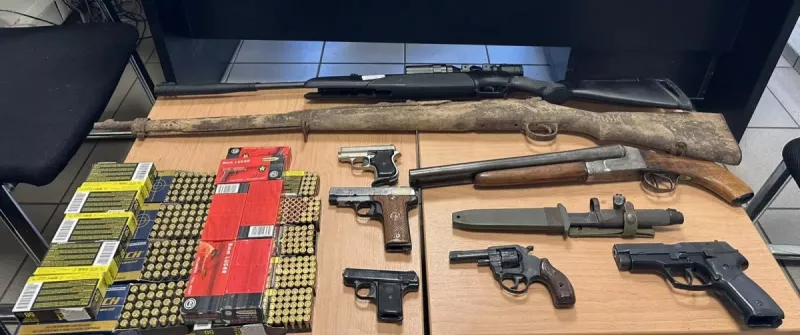Two criminal organizations, transnational, acting in cases antiquity were dismantled by police officers from the Patras Criminal Prosecution and Deletion. A total of 39 people were arrestedin Munich, Germany, Thessaloniki, Rhodes, Agrinio, Vonitsa, Mesolongi, Preveza, Karditsa, Trikala, Larissa, Lamia, Livadia, Polygyros, Ierissos, Kavala, Kavala, Kavala, Kavala, Kavala, Kavala, Kavala, Serres.
At the same time, a request for judicial assistance in the US And it was activated through the judicial authorities and Eurojust, a European research order in Germany.
In particular, according to police, The first criminal organization It consisted of a total of 36 members, 32 of which were arrested in Greece, while four more members are sought in Germany and Greece. At the same time, the full details of another 11 defendants involved in the case were identified.
As part of the investigation, police have distinguished that by 2022, the defendants were actively active, formed, formed and joined a criminal organization with a transnational character, hierarchical structure, internal structure, constant activity and specific methodology.
In addition, the transnational character of the criminal circuit was identified, as the illegally extracted ancient mobile monuments ended up abroad, either to their associates or in well -known auction houses operating in Germany and the US.
In the context of the preliminary investigation and at the request of a request for the US, a request for a European investigation order in Germany and the removal of bank confidentiality, it was revealed that members of the criminal organization committed at least 130 offenses against Greece’s cultural heritage.
As for the methodology of the criminal organization, this, according to the police, operated with structure and hierarchy, and in particular at the lower stage of the hierarchy of the archaeological circuit, were the defendants who, either individually or organized in subgroups, using appropriate machinery The purpose of revealing and theft of archaeological finds.
By using the metal detectors occupied by the defendants, they conducted investigations that revealed and removed metal ancient artifacts and mainly ancient coins.
In the next stage of hierarchy, there were the defendants who were initially displayed by the illegally found archaeological finds, either by living or in photographs, then assessed their value and subsequently assigned their further disposal.
The intermediaries, having appreciated the value of the ancient objects under movement, came into contact with the prospective buyer with whom they worked, described to him the antiquities, or sent him photos through online communication applications.
Although both sides agreed on the price offered, they completed the sale.
At the highest stage of hierarchy, there were the defendants who bought the antiquities, who, after gathering, exported them from Greece and handed them over to auction houses or their associates for their disposal.
These defendants had gained specialized archaeological knowledge of their dating, the types of performances that carry some of them and the value of corresponding objects that had been traded in the past as a point of reference. Most of the antiquities they bought were ancient coins and generally small objects, which were sold abroad, mainly in auction houses.
Communication between members were mainly performed with individual meetings at predetermined points, while in telephone conversations used coded expressions and terminology who had agreed in a previous year because of their chronic cooperation and who often referred to objects related to either their legal professional activity or objects found in the respective areas. Indeed, at a foreign auction house, a Greek national was found to be working, who has been arrested in Greece in Greece for antiquity and through it the ancient coins that had been exported illegally were traded.
The second criminal organization It consisted of a total of 10 members and of which seven were arrested in Greece, while three more members are sought. This criminal organization has been active since December 2023 in areas of Macedonia and Thrace, while some of its members had been concerned with the authorities in the past for similar cases. The members of the organization gathered ancient artifacts from Greece and then had them abroad, and all ancients were concentrated by the leader of the criminal organization and then was available abroad, where two auctions were found to be involved.
In the preliminary investigation, it was revealed that members of the second criminal organization committed at least 49 criminal offenses against Greece’s cultural heritage.
In the meantime, during the police operation, they were seized, inter alia:
* 1,800 archaeological finds, containing numerous coins of various periods and editions, animal and anthropomorphic figurines, as well as various objects in the form of ancient masks and helmets. In fact, 800 were found in investigations in Germany,
* 8 weapons
* 1,300 cartridges of various caliber
* 80,000 euros in cash
* 135,000 euros in bank accounts that committed
* A bank box
* 46 metal objects detection devices.
The archaeological finds are under consideration by officials of the competent Ephorate of Antiquities of Thessaloniki, who are expected to determine their exact archaeological value.
The detainees were taken to the Thessaloniki Public Prosecutor.
Source: Skai
I have worked as a journalist for over 10 years, and my work has been featured on many different news websites. I am also an author, and my work has been published in several books. I specialize in opinion writing, and I often write about current events and controversial topics. I am a very well-rounded writer, and I have a lot of experience in different areas of journalism. I am a very hard worker, and I am always willing to put in the extra effort to get the job done.












